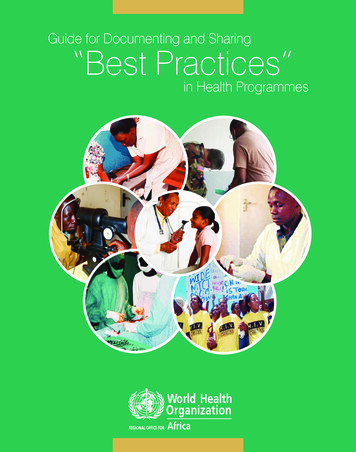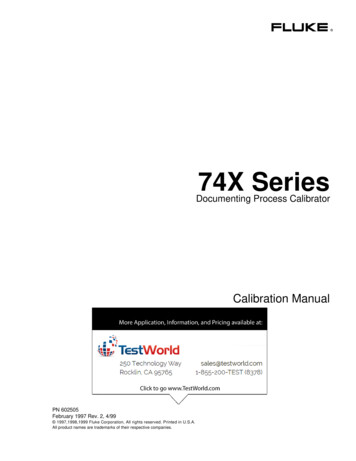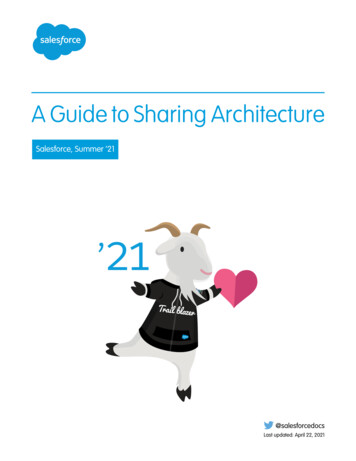
Transcription
Guide for Documenting and Sharing“Best Practices”in Health Programmes
Guide for Documenting and Sharing“Best Practices” in Health ProgrammesWORLD HEALTH ORGANIZATIONRegional Office for AfricaBrazzaville 2008
AFRO Library Cataloguing-in-Publication DataGuide for Documenting and Sharing “Best Practices” in Health Programmes1.2.3.4.5.6.Practice GuidelineManaged Care ProgramsInformation ManagementHealth Services AccessibilityHealth Systems PlansAfricaISBN : 92 9 023 132 7 (NLM Classification: W 84 HA1 ) WHO Regional Office for Africa, 2008Publications of the World Health Organization enjoy copyright protection in accordance with the provisions of Protocol 2 of theUniversal Copyright Convention. All rights reserved. Copies of this publication may be obtained from the Publication and LanguageServices Unit, WHO Regional Office for Africa, P.O. Box 6, Brazzaville, Republic of Congo (Tel: 47 241 39100; Fax: 47 24139507; E-mail: afrobooks@afro.who.int). Requests for permission to reproduce or translate this publication – whether for sale or fornon-commercial distribution – should be sent to the same address.The designations employed and the presentation of the material in this publication do not imply the expression of any opinionwhatsoever on the part of the World Health Organization concerning the legal status of any country, territory, city or area or of itsauthorities, or concerning the delimitation of its frontiers or boundaries. Dotted lines on maps represent approximate border linesfor which there may not yet be full agreement.The mention of specific companies or of certain manufacturers’ products does not imply that they are endorsed or recommendedby the World Health Organization in preference to others of a similar nature that are not mentioned. Errors and omissions excepted,the names of proprietary products are distinguished by initial capital letters.All reasonable precautions have been taken by the World Health Organization to verify the information contained in this publication.However, the published material is being distributed without warranty of any kind, either express or implied. The responsibility forthe interpretation and use of the material lies with the reader. In no event shall the World Health Organization or its Regional Officefor Africa be liable for damages arising from its use.Printed in India
CONTENTSParagraphs1. INTRODUCTION1–52. WHAT IS A “BEST PRACTICE”?6–83. EXAMPLES OF “BEST PRACTICES”9–134. WHERE DO “BEST PRACTICES” COME FROM?14–155. PROCEDURES FOR IDENTIFYING AND DOCUMENTING“BEST PRACTICES”16–235.1 Criteria for Selection of “Best Practices”5.2 Documenting “Best Practices”5.3 Submitting a Proposed “Best Practice”6. DISSEMINATING AND SHARING “BEST PRACTICES”16–1718–2021–2324–287. CONCLUSION29ANNEXESPage1. “Best Practice” Submission Form2. Terms of Reference of the WHO Regional Office Working Groupon “Best Practices”89
1. INTRODUCTION1. One of the five core functions of WHO is “shaping the research agenda, and stimulatingthe generation, dissemination and application of knowledge”. This function underscoresthe importance of knowledge for formulating health strategies at both national and globallevels and for the efficiency of health systems performance. In addition, populations needaccess to reliable information and knowledge on health risks and how to avoid them. WHOrecognizes the importance of knowledge management methods and tools in the performanceof this core function in order to improve effectiveness and efficiency.2. The WHO Regional Committee for Africa at its fifty-sixth Session in 2006 adoptedstrategic directions and a related resolution on Knowledge Management (KM).1 The strategic directions seek “to contribute to the improvement of health system performance andoutcomes through effective KM in health”. The resolution recognizes that KM is all aboutproviding the right knowledge for the right people (policy-makers, practitioners, health systems managers and the general public) and in the right format in order to strengthen healthsystems and improve health outcomes.3. One of the specific objectives of the strategic directions is “to maximize the impactof explicit and tacit knowledge, including health research and experiential knowledge,through effective knowledge sharing and application”. That will enable countries to benefittremendously from exchanging experience and hard-won solutions with one another.4. However, one of the significant barriers to knowledge sharing and reapplication ofexperience is the limited culture of information and knowledge documentation and sharing.Although relevant knowledge may exist in people’s minds, it cannot always be tapped or mayexist in formats that hamper people’s ability to know it or find it. The foregoing underscoresthe need for decision makers, health professionals, communities, and indeed WHO staffto be able to find, use and share knowledge on experiences of what works and the lessonslearned.5. In light of the above, the WHO Regional Office for Africa will be disseminating a series of country experiences in the planning, implementation and monitoring of health programmes and services that can be considered as “Best Practices”. This document providesguidance to WHO staff, ministries of health and civil society organizations on the process foridentifying, documenting and sharing knowledge on these experiences that can contributeto the acceleration and expansion of health sector actions.1Knowledge management in the WHO African Region: Strategic Directions; and resolution AFR/RC56/16 and AFR/RC56/R8.1
2. WHAT IS A “BEST PRACTICE”?6. A “Best Practice” is commonly defined as “a technique or methodology that, throughexperience and research, has proven reliably to lead to a desired result.2 The term is usedfrequently in areas such as health, government administration, the education system, projectmanagement, and others. In the context of health programmes and services, a practicaldefinition of a “Best Practice” is “knowledge about what works in specific situations andcontexts, without using inordinate resources to achieve the desired results, and which canbe used to develop and implement solutions adapted to similar health problems in othersituations and contexts”.7. The use of the word “best” should not be considered in the superlative sense. In otherwords, the term “Best Practice” is not about “perfection”, the “gold standard” or only elements that have been shown to contribute towards making interventions work or successful.3 Results can be partial and may be related to only one or more components of the practice being considered. Indeed, documenting and applying lessons learned on what does notwork and why it does not work is an integral part of “Best Practice” so that the same typesof mistakes can be avoided by other programmes and projects.8. There are several creative and constructive actions by people and organizations in thehealth sector to improve health outcomes of people. Making knowledge of such actionswidely available may prevent the repetition of mistakes and loss of valuable time. Thus,the main rationale for documenting and sharing “Best Practices” is to enable persons andorganizations working in the health sector to avoid “re-inventing the wheel”; to “learn inorder to improve performance” and; to “avoid the mistakes of others”. Documenting andsharing “Best Practices” affords one the opportunity to acquire knowledge about lessonslearned and to continue learning about how to improve and adapt strategies and activitiesthrough feedback, reflection and analysis in order to implement larger-scale, sustained, andmore effective interventions. A commitment to using a “Best Practice” is a commitment tousing the body of knowledge and technology at one’s disposal to ensure success.3. EXAMPLES OF “BEST PRACTICES”9. A “Best Practice” could be related to the implementation of a programme, a project, apolicy, a legislation, a strategy, an activity, a manual, etc. Practical examples of areas where“Best Practices” may be documented and shared have been provided in paragraphs actices.html.UNAIDS Best Practice Collection.
10. Strategies like the Integrated Management of Childhood Illness (IMCI) and the Directly-Observed Treatment – Short Course (DOTS) have been implemented in several countriesin the Region for some years. These have, in some countries, led to health improvementsincluding in child survival and TB cure rates. The several lessons learned need to be documented and shared.11. Because of their central position in people’s lives, the mass media have unrivalledpotential to inform and educate the general public about health issues. There are examplesof imaginative and highly successful mass media campaigns for immunization, HIV/AIDS,malaria, and other programmes. The mass media have been used to, among other things,stimulating and leading open discussions on health issues, to encourage leaders to takeaction, and to keep policy makers and service providers on their toes. These experiencesneed to be catalogued and shared.12. Community-based organizations have emerged to provide essential services inHIV-related prevention, care and treatment. They have done so in response to the desperateneeds of those affected by the epidemic and to fill gaps in the public sector’s provisionof these services. As anti-retroviral medicines have become more affordable, communitybased organizations have fought for and enabled greater access to treatment, includinganti-retroviral therapy.13. In all the above experiences and others, what is important is to document and shareknowledge on what elements of these work or do not work, how they work, and why theywork or do not work.4. WHERE DO “BEST PRACTICES” COME FROM?14. A “Best Practice” may come from a variety of sources including: WHO staff; ministriesof health; civil society organizations; community groups; and individuals.15. Submissions from any of the above sources are to be sent in electronic form withdetailed supporting documents. Some practices may be subjected to formal evaluation. Thishowever is not required in most cases because formal evaluation is often a slow, complicated,expensive and time-consuming process that sometimes costs more than the actual processbeing evaluated. However, documentation of the outcomes and lessons learned is crucial.5. PROCEDURES FOR IDENTIFYING AND DOCUMENTING “BESTPRACTICES”5.1 Criteria for Selection of “Best Practices”16. Identifying “Best Practices” involves judgement. Such judgements require prior analysisusing the following set of criteria: effectiveness, efficiency, relevance, ethical soundness,3
sustainability, possibility of duplication, partnership, community involvement, and politicalcommitment.Effectiveness:This is a fundamental criterion implicit in the definition. Thepractice must work and achieve results that are measurable.Efficiency:The proposed practice must produce results with a reasonablelevel of resources and time.Relevance:The proposed practice must address the priority health problemsin the WHO African Region.Ethical soundness:The practice must respect the current rules of ethics for dealingwith human populations.Sustainability:The proposed practice must be implementable over a long periodof time without any massive injection of additional resources.Possibility ofduplication:The proposed practice, as carried out, must be replicableelsewhere in the Region.Involvement ofpartnerships:The proposed practice must involve satisfactory collaborationbetween several stakeholders.Communityinvolvement:The proposed practice must involve participation of the affectedcommunities.PoliticalcommitmentThe proposed practice must have support from the relevantnational or local authorities.17. By definition, a “Best Practices” should meet at least the “effectiveness”, “efficiency”and “relevance” criteria in addition to one or more of the other criteria. A “Best Practice”needs not meet all the above criteria. This is because a “Best Practice” can be anything thatworks to produce results without using inordinate resources, in full or in part, and that canbe useful in providing lessons learned.5.2 Documenting “Best Practices”18. To ensure readability and a clear presentation of what makes a practice innovative, interesting, informative and, indeed, a “Best Practice”, the following format should be used:(a)4Title of the “Best Practice”This should be concise and reflect the practice being documented.
(b) IntroductionThis should provide the context and justification for the practice and address thefollowing issues:what is the problem being addressed?which population is being affected?how is the problem impacting on the population?what were the objectives being achieved?(c)Implementation of the Practicewhat are the main activities carried out?when and where were the activities carried out?who were the key implementers and collaborators?what were the resource implications?(d) Results of the Practice – Outputs and Outcomeswhat were the concrete results achieved in terms of outputs and outcomes?was an assessment of the practice carried out? If yes, what were the results?(e)Lessons Learntwhat worked really well – what facilitated this?what did not work – why did it not work?(f)Conclusionhow have the results benefited the population?why may that intervention be considered a “Best Practice”?recommendations for those intending to adopt the documented “Best Practice” or how it can help people working on the same issue(s).(g)Further Readingprovide a list of references (not more than six) that give additional information on the “Best Practice” for those who may be interested in how theresults have benefited the population.19. The above write-up should not exceed 1500 words. It should be prepared in MicrosoftWord, in double-line spacing, using font size 12 (approximately five pages).20. The contribution can be submitted in any one of the three official languages of theWHO African Region - English, French and Portuguese.5
5.3 Submitting a Proposed “Best Practice”21. A proposed “Best Practice’ and its cover page (Annex 1) should be submitted by electronic mail to a dedicated Regional Office e-mail address: best practice@afro.who.int.Copies must be sent to the respective WHO representative (for the national counterparts ofthe WHO country office staff) or to the Divisional Director (for staff of the WHO RegionalOffice and Intercountry Support Team).22. The cover page is to serve as a summary and encourage the one proposing the “BestPractice” to clearly articulate what makes the submission a “Best Practice”.23. Internal mechanisms will be established in the WHO Regional Office for Africa to coordinate the Regional Office’s work related to “Best Practices”, to assess submissions and tonotify contributors (Annex 2).6. DISSEMINATING AND SHARING “BEST PRACTICES”24. Three main methods of dissemination will be used. The first method will involve issuinga publication entitled “African Regional Best Practice Series”. Each issue of the series willinclude “Best Practices” that will promote learning and sharing of experience. Each practicewill be preceded by a brief introduction to the topic and contain a section called “FurtherReading” that will help readers find bibliographies for obtaining more information on thesubject.25. It is expected that the series will inspire Member States to replicate the good works ofmanagers and front-line health workers in the African Region and to scale up their healthsector interventions. Furthermore, the series will demonstrate to both policy makers anddonors the valuable contributions of these workers, contribute to the integration of thesepractices in national and district health plans, and help mobilize resources in support ofprogrammes.26. The second method will involve the use of the Regional Office Website. A webpage will be created on the Regional Office Website to promote and share the “AfricanRegional Best Practice Series”. This web page will include a summary database on all“Best Practices” published. Full texts of the series will be accessible on the web page.Web links will be established with the health topics of the Regional Office Website. E-mailnotification messages will be sent to all Regional Office professional staff each time a“Best Practice” has been added to the Regional Office website.27. The third method will involve the distribution of CD-ROMs containing “Best Practices”during WHO Regional Committee meetings and intercountry conferences, workshops andmeetings. Sets of CD ROMs will be sent directly to WHO country offices for distribution todistrict health management teams that do not have ready access to the internet.28. Additional methods for dissemination will be used as appropriate.6
7. CONCLUSION29. The documentation and dissemination of “Best Practices” provides real opportunitiesfor acquiring knowledge about what works and to continue learning about how to improveand adapt strategies and activities through feedback, reflection and analysis in order toimplement larger-scale, sustained, and more effective interventions. The staff of the WHORegional Office for Africa, partner organizations, ministries of health and other stakeholdersin Member States of the WHO African Region are encouraged to take advantage of theseopportunities and participate fully in the efforts to share “Best Practices” in the health sector.7
Annex 1: “Best Practice” Submission FormPlease fill out this form by typing your responses in the appropriate box.Originator of request:Name:Title:Postal address:Email address:Telephone number:Names and addresses of contributors:Focal point in the Regional Office (if any):Name:Unit:Tel:Title of Best PracticeSummary of Best Practice (not more than 5 lines)What makes it a Best Practice? (not more than 3 lines)Place8Date
Annex 2: Terms of Reference of the WHO REGIONAL OFFICEWorking Group on “Best Practices” Identify key policy, thematic and programme areas to be covered by the Best PracticeSeries. Suggest and review methodologies for assessing and evaluating Best Practices. Propose members of ad hoc selection groups to review individual proposed BestPractices. Review and include contributions from divisions, country offices and other partners forinclusion in the Regional Office Best Practice Collection. Determine and expand dissemination at global, regional and country levels. Promote the African Regional Best Practice Series. Produce annual reports on the African Regional Best Practice Series.9
5.1 Criteria for Selection of "Best Practices" 16-17 5.2 Documenting "Best Practices" 18-20 5.3 Submitting a Proposed "Best Practice" 21-23 6. DISSEMINATING AND SHARING "BEST PRACTICES" 24-28 7. CONCLUSION 29 ANNEXES Page 1. "Best Practice" Submission Form 8 2. Terms of Reference of the WHO Regional Office Working .










